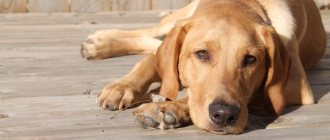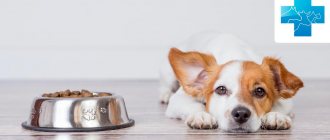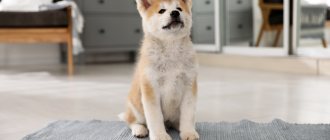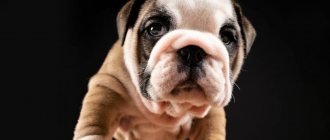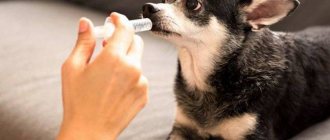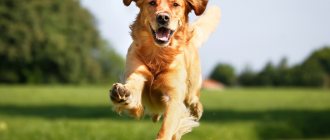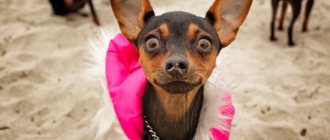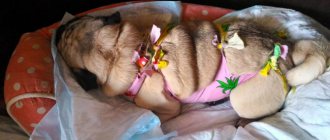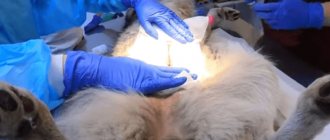Incontinence or incontinence is uncontrolled urination. Usually manifests itself by the appearance of wet spots anywhere. Urinary incontinence in a dog after spaying and neutering is an important prognostic sign. To understand the situation, the veterinarian needs to become familiar with the manifestations of the pathological symptom complex and the history of the disease, study the results of blood and urine tests, including hormonal studies, as well as ultrasound data of internal organs. Urine culture and x-ray examination are often required.
What is urinary incontinence
This is the name for the process of unconscious release of urine from the bladder into the external environment. In most cases, this pathology is a consequence of improper functioning and weakness of the bladder sphincter. Accordingly, when a sufficient volume of fluid accumulates in the organ cavity, it simply begins to leak due to increased pressure.
The type of incontinence described above is called “sphincteric insufficiency” and is the most common form of pathology (not only in veterinary medicine, but also in medicine). In general, there are many possible etiological prerequisites for incontinence, but in this case we are interested in only one type - incontinence that occurred in an animal due to sterilization.
Content
1. Main causes and methods of eliminating them 2. No need for euthanasia
Removing the testicles of a male dog is a necessary measure, which owners are often reluctant to do. This is done to achieve the following goals:
- Reduced aggression. Males of this species may show excessive intolerance towards their own kind due to the large amount of hormones produced.
- The owner does not want to look for a mate for mating due to unnecessary hassle or rejection of the pet for a number of reasons.
- Removal of the gonads is a measure prescribed by a doctor. This is possible in the presence of cancer or severe injuries.
Regardless of the reasons for castration, during the postoperative period and after its completion, an unpleasant phenomenon may occur when urine constantly leaks. This is an involuntary process that does not depend on external factors, so you should not scold the animal. It only makes sense to consult a doctor for help, be patient and have absorbent diapers.
Breed predisposition
Until recently, it was believed that incontinence could equally well develop in a dog of any breed, but statistics accumulated by veterinarians around the world indicate that everything is not so simple. Today, experts believe that the risk of incontinence is extremely high in sterilized representatives of the following breeds:
- Pinchers.
- Golden Retrievers.
- Rottweilers and boxers.
- Setters (especially large and giant ones).
- Schnauzers (also giant).
- Interestingly, many herding dog varieties are susceptible to the same pathology.
Causes of pathology
If there is such a problem, the animal’s condition cannot be left to chance. The problem will only get worse, so it is important to take your pet to the vet in a timely manner. Under no circumstances should an animal be overcooled, even if the dog lived outside before sterilization. To establish an accurate diagnosis, blood and urine are taken and an ultrasound of the genitourinary system is performed. There can be many reasons, let’s look at the most common ones:
- genitourinary tract infections, weak bladder;
- spinal injuries and injuries;
- Polypsidia – diseases that involve drinking too much water. For example, diabetes;
- central nervous system disorder;
- congenital changes in physiology;
- changes associated with age;
- weakness of the urethral muscles.
Depending on the diagnosis, treatment may be medication or surgery. In many cases, the problem can be resolved with antibiotics or sedatives. Sometimes the doctor prescribes hormones.
Treatment of incontinence in dogs
Drug therapy shows good results. So, phenylpropanolamine is very good. In veterinary medicine, its analogue, propalin, is usually used. The action of the drug is based on stimulation of the urethral sphincter.
Interesting! If its administration is started in a timely manner, the effectiveness of therapy can reach 75%-90%.
If for some reason the effect of the injection is low, use the medical drug Ovestin . But! This medicine should only be used under constant veterinary supervision, as there is a high likelihood of severe side effects (including suppression of red bone marrow function).
A more radical treatment method is to inject collagen into the bladder sphincter area. The operation is extremely expensive, since a special endoscope is used for this. The advantages of the procedure include its high efficiency: even in advanced cases, it is possible to significantly improve the animal’s condition. Alas, in addition to its high cost, this technique requires such specific equipment and such highly qualified specialists that it is carried out only in a few clinics.
Veterinary clinic of Dr. Shubin
Description and reasons
Urinary incontinence is the involuntary release of urine from the bladder into the environment.
Urinary incontinence usually develops when the urethral sphincter (the muscle group that keeps the bladder closed) is weak, leading to involuntary (unconscious) leakage of urine as it accumulates in the bladder. Urinary incontinence in dogs after neutering is scientifically referred to as primary insufficiency of the sphincter mechanism and is the most common form of incontinence in dogs. This form of urinary incontinence has multiple synonyms, such as urinary incontinence responding to treatment with hormones, urinary incontinence responding to treatment with estrogen, urinary incontinence after castration and some others.
In this text, for ease of understanding, urinary incontinence in dogs after castration will be defined simply as urinary incontinence.
Urinary incontinence after neutering dogs develops after spaying, the average time for symptoms to develop after surgery is about 3 years. Based on this, the main reason for the development of the disease is considered to be a decrease in the level of ovarian sex hormones in the body (lack of estrogen). The likelihood of incontinence also depends on the time of the operation (at what age the dog was sterilized), but the optimal time for the operation has not yet been determined. An interesting fact is that this form of incontinence can also occur in male dogs after castration; it is difficult to correct, but fortunately it occurs very, very rarely.
Despite the pronounced relationship between sterilization and the development of urinary incontinence, the exact causes of the disease have not been fully identified; several other factors may act as the cause of urine leakage, such as a decrease in the response of urethral receptors, abnormal position of the bladder and cervix (displacement into the pelvic cavity from the abdominal ), obesity and abnormalities of the vaginal vestibule. It is generally accepted that several factors (together or separately) may play a role in the manifestation of urinary incontinence.
Any dog can develop urinary incontinence after neutering, but there is some predisposition, the following breeds are at increased risk of developing urinary incontinence: Doberman Pinscher, Labrador Retriever, Boxer, Rottweiler, Irish Setter, Giant Schnauzer, Old English Cattle Dog, German Cattle Dog , English Springerspaniel and Weimaraner. Also, in purebred dogs, incontinence control is achieved with some difficulty compared to ordinary mongrels.
Urinary incontinence should not be confused with urinating in the wrong place or at the wrong time (uncleanliness); when incontinence develops, the dog does not realize what is happening; when uncleanliness occurs, voluntary urination occurs.
Clinical signs
As mentioned above, urinary incontinence after sterilization develops 3 years after surgery (average period), the incidence of this urinary incontinence is about 20%, i.e. Every fifth sterilized dog shows signs of urine leakage of varying severity (average statistics for the entire population of sterilized dogs). But urinary incontinence rarely develops in small and medium-sized dogs; in the vast majority of cases, dogs with a body weight of more than 20 kg are predisposed to it.
A characteristic clinical sign of urinary incontinence after sterilization is the leakage of urine in drops during sleep or when the animal rests on its side. Urinary incontinence can be observed in a dog constantly, it can subside for a while, and then return again, but you should not expect a complete cessation of symptoms. The severity of the symptoms or the amount of urine lost during rest is quite varied, it depends on the degree of damage to the bladder sphincter, they vary significantly in each specific case.
Complications of urinary dysfunction after sterilization are bacterial inflammation of the constantly moisturized perineal skin and the development of a secondary infection of the lower urinary tract. When the skin becomes inflamed due to leakage of urine (urinary burns), focal loss of hair, reddening of the skin and formation of crusts are observed around the vagina. Complications of the disease include the addition of a lower urinary tract infection (bacterial cystitis), with new signs appearing: the frequency of urination increases in a conscious state.
Feeding the animal a diet high in salt and severe systemic diseases of the dog (eg chronic kidney disease, Cushing's syndrome) worsen the signs of urinary incontinence.
Diagnostics
The diagnosis of urinary incontinence in spayed female dogs is made based on the characteristic signs of the disease (urine leakage during sleep and at rest), as well as the response to a trial treatment. In some cases, additional diagnostic tests are used - radiographic and ultrasound examination of the bladder, urine tests, blood tests, etc.
Treatment
In the treatment of animals with urinary incontinence after sterilization, medical and surgical methods are used; in most cases, a selection of drugs is sufficient. Ideally, all animals with this type of urinary incontinence benefit from subcutaneous collagen injections, but this type of treatment is characterized by poor availability and high cost. Next, methods of treating urinary incontinence after sterilization are described in a little more detail.
Drug treatment
The drug of choice for urinary incontinence after neutering dogs is phenylpropanolamine (available as the veterinary drug propalin), this type of drug increases bladder sphincter function. The effectiveness of treatment with propalin is about 75%-90%. If propalin is insufficiently effective, a dog with incontinence is prescribed drugs of female sex hormones (eg the female drug Ovestin), they are highly effective, but carry with them the likelihood of developing some side effects (eg signs of estrus, bone marrow suppression). In some cases of urinary incontinence, the combined use of phenylpropanolamine with estrogens is used, and some other drugs may also be prescribed. In each specific case, the selection of drug treatment is carried out by a veterinary clinic doctor together with the animal owner
Collagen injection under the urethral mucosa
With this type of treatment of urinary incontinence, after sterilization using complex endoscopic equipment, collagen is injected under the mucous membrane in the sphincter area, and an improvement in urination is always noted (from complete resolution of the problem to smoothing out the symptoms). This type of treatment requires both expensive equipment and high professionalism of a veterinarian; in Russia it is available only in a few clinics.
Colposuspension
The essence of colposuspension is that the vagina is surgically pulled into the abdominal cavity using a special suture material to the pubic bones. After this operation, in most cases, relief from the symptoms of urinary incontinence is achieved, but a year after the operation the positive effect disappears.
Forecasts
Urinary incontinence after sterilization of dogs, in most cases, can be either reduced to zero with medication or significantly mitigated clinical manifestations. Persistent and untreatable cases of incontinence in dogs are rare.
Urinary incontinence affects the owner of the animal more, causing him some inconvenience; the disease does not have a significant effect on the general condition of the dog.
Veterinary clinic of Dr. Shubin, Balakovo
What are the symptoms of incontinence?
If the cause of sphincter weakness is the animal's past sterilization surgery, drops of urine will most likely appear during sleep or when the dog rests on its side. True, one should not exclude the possibility of fluid leakage at other times, especially while the animal is jogging or sitting.
Important! Do not confuse urinary incontinence with full urination in the wrong place. In the first case, the dog is not aware of what is happening, but the animal’s uncleanliness is a completely conscious phenomenon and requires correction in education.
The problem may disappear for a while, but then it still appears again, which is usually associated with changes in weather conditions outside or a change in the dog’s life rhythm. The owner can notice that something is wrong by looking at wet spots on the bedding, floor or furniture in the house, although the fur under the tail often remains wet.
Prevention of recurrence
Preventive measures depend entirely on the cause of incontinence. Monitor your dog's behavior and nutrition if it comes to hormonal imbalances. Hypothermia should not be allowed - inflammatory processes may develop. If the cause is an infectious disease, change your pet’s regimen, add vitamin supplements to the diet, and consult a veterinarian. He will prescribe a complex, taking into account the age, weight and health status of the animal. If you see behavioral disturbances, be sure to show your pet to a doctor - do not delay to prevent critical situations.
